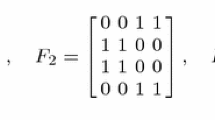Abstract
A frequency square is a square matrix in which each row and column is a permutation of the same multiset of symbols. A frequency square is of type \((n;\lambda )\) if it contains \(n/\lambda \) symbols, each of which occurs \(\lambda \) times per row and \(\lambda \) times per column. In the case when \(\lambda =n/2\) we refer to the frequency square as binary. A set of k-MOFS\((n;\lambda )\) is a set of k frequency squares of type \((n;\lambda )\) such that when any two of the frequency squares are superimposed, each possible ordered pair occurs equally often. A set of k-maxMOFS\((n;\lambda )\) is a set of k-MOFS\((n;\lambda )\) that is not contained in any set of \((k+1)\)-MOFS\((n;\lambda )\). For even n, let \(\mu (n)\) be the smallest k such that there exists a set of k-maxMOFS(n; n/2). It was shown in Britz et al. (Electron. J. Combin. 27(3):#P3.7, 26 pp, 2020) that \(\mu (n)=1\) if n/2 is odd and \(\mu (n)>1\) if n/2 is even. Extending this result, we show that if n/2 is even, then \(\mu (n)>2\). Also, we show that whenever n is divisible by a particular function of k, there does not exist a set of \(k'\)-maxMOFS(n; n/2) for any \(k'\leqslant k\). In particular, this means that \(\limsup \mu (n)\) is unbounded. Nevertheless we can construct infinite families of maximal binary MOFS of fixed cardinality. More generally, let \(q=p^u\) be a prime power and let \(p^v\) be the highest power of p that divides n. If \(0\leqslant v-uh<u/2\) for \(h\geqslant 1\) then we show that there exists a set of \((q^h-1)^2/(q-1)\)-maxMOFS(n; n/q).

Similar content being viewed by others
References
Britz, T., Cavenagh, N.J., Mammoliti, A., Wanless, I.M.: Mutually orthogonal binary frequency squares. Electron. J. Combin. 27(3) (2020), #P3.7, 26 pp.
Cox, D.A., Haase, C., Hibi, T., Higashitani, A.: Integer decomposition property of dilated polytopes. Electron. J. Combin. 21(4) (2014), #P4.28, 17 pp.
Danziger P., Wanless I.M., Webb B.S.: Monogamous Latin squares. J. Combin. Theory Ser. A 118, 796–807 (2011).
Dougherty S.T.: A coding theoretic solution to the 36 officer problem. Des. Codes Cryptogr. 4, 123–128 (1994).
Dukes P., Howard L.: Group divisible designs in MOLS of order 10. Des. Codes Cryptogr. 71, 283–291 (2014).
Federer W.T.: On the existence and construction of a complete set of orthogonal \(F(4t;2t,2t)\)-squares design. Ann. Stat. 5, 561–564 (1977).
Hedayat A., Raghavarao D., Seiden E.: Further contributions to the theory of \(F\)-squares design. Ann. Stat. 3, 712–716 (1975).
Jedwab, J., Popatia, T.: A new representation of mutually orthogonal frequency squares. J. Combin. Math. Combin. Comput., to appear.
Jungnickel D., Mavron V.C., McDonough T.P.: The geometry of frequency squares. J. Combin. Theory Ser. A 96, 376–387 (2001).
Laywine C.F., Mullen G.L.: A table of lower bounds for the number of mutually orthogonal frequency squares. Ars Combin. 59, 85–96 (2001).
Li M., Zhang Y., Du B.: Some new results on mutually orthogonal frequency squares. Discret. Math. 331, 175–187 (2014).
Mavron, V.C.: Frequency squares and affine designs. Electron. J. Combin. 7 (2000), #R56.
Rosser J.B., Schoenfeld L.: Approximate formulas for some functions of prime numbers. Ill. J. Math. 6, 64–94 (1962).
Stinson D.: A short proof of the non-existence of a pair of orthogonal Latin squares of order six. J. Combin. Theory Ser. A 36, 373–376 (1984).
Street D.J.: Generalized Hadamard matrices, orthogonal groups and \(F\)-squares. Ars Combin. 8, 131–141 (1979).
Acknowledgements
This work was supported in part by Australian Research Council Grant DP150100506.
Author information
Authors and Affiliations
Corresponding author
Additional information
Communicated by J. Jedwab.
Publisher's Note
Springer Nature remains neutral with regard to jurisdictional claims in published maps and institutional affiliations.
Rights and permissions
About this article
Cite this article
Cavenagh, N.J., Mammoliti, A. & Wanless, I.M. Maximal sets of mutually orthogonal frequency squares. Des. Codes Cryptogr. 89, 525–558 (2021). https://doi.org/10.1007/s10623-020-00832-w
Received:
Revised:
Accepted:
Published:
Issue Date:
DOI: https://doi.org/10.1007/s10623-020-00832-w



